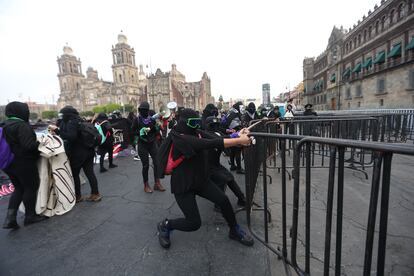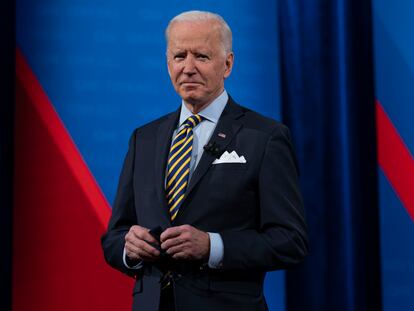In Mexico, feminism knocks furiously at the doors of the presidential palace
Galvanized by the ‘Salgado Macedonio’ sexual assault case, the movement is taking center stage in national politics with unprecedented force ahead of a key state election


The women’s movement in Mexico is starting to shake the National Palace, the seat of the federal executive and official residence of the president. It is a threat that could either cost or win votes. Women in Mexico have put gender equality and ending violence against them at the center of the political debate. In recent days, their struggle – which has grown to a scale unprecedented in Mexico – has questioned the country’s institutions, its political parties and its public figures.
The political storm surrounding Félix Salgado Macedonio, a member of the governing National Regeneration Movement (Morena) who has been nominated to run for governor of the state of Guerrero despite two rape accusations and several counts of sexual assault, is just the latest blow against the administration of Andrés Manuel López Obrador. Since López Obrador took office, his government has struggled with its approach to women’s fight for greater rights.
There were more signs of tension on Tuesday, when dozens of activists gathered in the Zócalo, the central square in Mexico City, while the president was holding his daily press conference. The protesters were stopped by the police before they could reach him, but their yells could be heard in the square: “A rapist cannot be a governor!” they called out, in reference to the accusations against Salgado Macedonio. Their demands have put López Obrador on the back foot. The president – who has never been comfortable with the feminist movement – has tried to frame the protest as politically motivated – in other words, a plot by his enemies to gain more support ahead of the election in Guerrero. But with International Women’s Day just days away and the vote for governor in three months, neither side is showing signs of giving up.
The demands of the women’s movement are legitimate and they go beyond political parties and electionsCristina Santana, Redefine México
“The women’s movement in Mexico has been gaining a lot of traction in the last year, it’s a great momentum that should be used to visibilize violence [against women] and make gains,” says Wendy Briceño, the president of the equality committee in Congress. “Sexism is being stripped bare and female victims are putting themselves at the center of the debate. Because we have all been victims in one way or another, but some cases are more horrifying than others.” Briceño is one of 500 members of Morena who have demanded that Salgado Macedonio be withdrawn as a candidate.
According to Melissa Fernández Chagoya, professor at Claustro de Sor Juana University, the rise of the women’s movement and its growing presence in public life is due to three factors. “On the one hand, it is an achievement of the institutionalization of feminism, with many women now holding positions of state, which is an achievement of liberal feminism,” she says. “On the other hand, [it is due] to the bravery of young women and their fight on the street, which is bringing visibility to the cause; and finally, the movement is making an impact on social-digital media. Now we are finding out more things than ever before, even at a local level.”
The veteran feminist Patricia Olamendi, who is an outspoken critic of the Mexican government’s gender equality program, believes the strength of the movement lies in the fact that it is putting women’s problems front and center, “compared with a rhetoric that doesn’t understand what’s going on and categorizes everything in the usual boxes: its enemies, its adversaries, the far right.”
“Whoever says that just doesn’t get it,” adds Olamendi. “They are unable to see the scale of a movement that is political and social and all about demanding rights. It is an insurgency for rights.”
This particular case has attracted media coverage and it will ultimately be forgotten. But we should praise the progress that it has brought aboutMelissa Fernández Chagoya, Claustro de Sor Juana University
Women protested outside the presidential palace on Wednesday, and outside the Guerrero attorney general’s office the day before. In Guerrero, protesters spilled red paint and called on the justice system to clarify how the case against Salgado Macedonia is progressing. Women in Mexico do not want to wait any longer. “The demands of the women’s movement are legitimate and they go beyond political parties and elections,” says Cristina Santana from Redefine Mexico, a department focused on youth within the Simone de Beauvoir Institute. “It’s important that a person who has been formally reported [for rape and sexual harassment] not be allowed to hold political office, regardless of what party they belong to.” At 27, Santana is one of the voices underscoring the strength of the women’s movement in Mexico.
The coming months will be key to determining what impact the movement will have on the June election for governor of Guerrero. The clashes between feminists and López Obrador began early in his term and have not let up. Violence against women has not lessened, with Mexico recording an average of 10 deaths a day. What has visibly diminished are the hopes many feminists had in the government of López Obrador. Disappointment and disillusionment are the words most often used to describe how they feel about the president’s gender equality program.
In his morning press conferences, López Obrador has made some terrible gaffes while discussing women’s problems, such as the time he became angry at a journalist who asked him about the murder of Ingrid Escamilla, a 25-year-old woman attacked by her partner in February 2020. Instead of responding to the question, the president chose to continue talking about his presidential plane – a sign that he did not have a hold on feminist discourse. Despite this, his followers claim he is the most feminist president Mexico has ever had. López Obrador avoids this definition and prefers to call himself a “humanist.”
Women also raised their voice when Mexico’s attorney general, Alejandro Gertz Manero, suggested addressing femicides without a gender perspective. It was yet another sign that the women’s movement in Mexico was not willing to remain silent.
Society is telling the movement that it is right, that what’s happening is real, that violence is realPatricia Olamendi, veteran feminist
At Tuesday’s press conference, asked about a Twitter message from former conservative president Felipe Calderón condemning the nomination of Salgado Macedonio, López Obrador replied: “So now Calderón is a feminist, what else is there left to say?” The president believes that feminism belongs to the left, something that the women’s movement rejects. Sometimes López Obrador puts the movement in the context of the greater social struggle, a comparison that the suffragettes of the 19th and 20th century already put an end to. Class struggle is one thing, women’s struggle, another. “From my experience, I know that feminism leans more towards the left than the center or the right, but now it permeates everything, it raises questions about the institutions and parties and political actors,” says Briceño. “Feminism does not exclude rights, and that is its commitment.”
This commitment will be put to the test at the election, and Briceño is sure that it will influence the process. “It’s obvious that it will, because it’s reaching all the public forums, the morning news conferences, Congress, the cameras...”
Cristina Santana agrees. “The movement is very strong and it is being expressed in a very public way, from the youngest [activists] to the older ones. It is defining the agenda. Women vote, they represent half of the country and our decisions as citizens are made with an eye on the people working to guarantee our rights,” she says. Asked about the political cost of the Salgado case, she says there is a demand to “break the pact.”
“[The president] needs to be made very aware that this does not mean breaking his alliances with men, but breaking with the complicity and the silence in the face of violence or discrimination.”
Fernández Chagoya fears that the Salgado case will end up being one of many that have dropped out of the collective consciousness. “The problem is structural. There are more cases of violence beyond Salgado. This particular case has attracted media coverage and it will ultimately be forgotten. But we should praise the progress that it has brought about.”
The president’s attitude towards the feminist movement has run into its biggest stumbling block with the Salgado Macedonio case. Proof of it is how strongly female members of his own party have spoken out about it, as well as members of his government, with messages siding with the victims and against the alleged attacker. So far López Obrador has deflected the issue, continuing to back a nominee who does not have a lot of support at street level.
“Of course this is going to have an electoral cost,” says Olamendi. “The feminist movement has been gaining a recognition that it lacked in society. And society is telling the movement that it is right, that what’s happening is real, that violence is real. The president should take steps and seek to talk with the movement, something that has yet to happen. He should talk to them, although he doesn’t seem to talk with anyone.”
English version by Melissa Kitson and Susana Urra.
Tu suscripción se está usando en otro dispositivo
¿Quieres añadir otro usuario a tu suscripción?
Si continúas leyendo en este dispositivo, no se podrá leer en el otro.
FlechaTu suscripción se está usando en otro dispositivo y solo puedes acceder a EL PAÍS desde un dispositivo a la vez.
Si quieres compartir tu cuenta, cambia tu suscripción a la modalidad Premium, así podrás añadir otro usuario. Cada uno accederá con su propia cuenta de email, lo que os permitirá personalizar vuestra experiencia en EL PAÍS.
¿Tienes una suscripción de empresa? Accede aquí para contratar más cuentas.
En el caso de no saber quién está usando tu cuenta, te recomendamos cambiar tu contraseña aquí.
Si decides continuar compartiendo tu cuenta, este mensaje se mostrará en tu dispositivo y en el de la otra persona que está usando tu cuenta de forma indefinida, afectando a tu experiencia de lectura. Puedes consultar aquí los términos y condiciones de la suscripción digital.
More information
Archived In
Últimas noticias
A hybrid building: Soccer pitch, housing, and a shopping mall
Europe urges Trump to respect Greenland following annexation threats
Science seeks keys to human longevity in the genetic mixing of Brazilian supercentenarians
Luisa Neubauer, climate change activist: ‘Ecology shouldn’t be a punitive force, but a joyful and liberating one’
Most viewed
- Alain Aspect, Nobel laureate in physics: ‘Einstein was so smart that he would have had to recognize quantum entanglement’
- Alvin Hellerstein, a 92-year-old judge appointed by Bill Clinton, to preside over Maduro’s trial in New York
- Cuba confirms death of 32 of its citizens in the US attack against Venezuela
- Gilles Lipovetsky: ‘If you want to live better and fall in love, take Prozac, don’t look to philosophy’
- Why oil has been at the center of Venezuela-US conflicts for decades










































